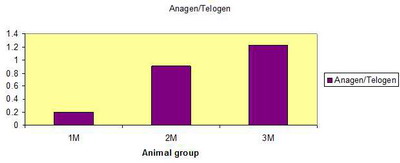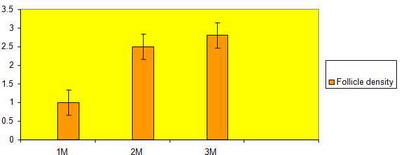|
|
Abstract
Hibiscus rosa sinensis leaves are well known as hair growth promoter
in traditional and folklore medicines. In this study, experiments were performed
on male albino rats for induction and development of androgenic alopecia
by subcutaneous dose of testosterone for three weeks (21 days). Animals
were divided into three groups and group one, two and three animals were
treated with vehicle, finasteride and ethanolic extract of Hibiscus rosa
sinensis leaves topically along with testosterone respectively. Animals
were observed for signs of alopecia on dorsal skin. After the treatment
period one animal from each group was euthanized and follicular morphology
and density were studied. The animals treated with testosterone and vehicle
become alopecic from the second week of treatment, while animals treated
with finasteride and ethanolic extract of Hibiscus rosa sinensis did not
become alopecic and follicular morphology study also supported this. We
concluded that ethanolic extract of H.rosasinensis posses significant anti
androgenic alopecia activity as proved by this study and it is comparable
to standard FDA approved drug for androgenic alopecia finasteride.
Introduction
Alopecia has a great impact on a person's self-respect, mental health,
and overall quality of life. The disorder, androgenic alopecia (AGA) is
the most common type of hair loss, which affects large numbers of both men
and women. [1] It affects at least half
of all men by the age of 50, and up to 70% of 70-year-old men. [2]
AGA is caused by excessive activity of the 5alpha reductase enzyme in hair
follicles. [3] At present, there are some
medicines that are used to treat AGA. For example, 5alpha reductase inhibitors,
finasteride and dutasteride, are used to treat androgen-related disorders.
[4] But these medicines have several undesirable
side effects, for example, impotence (erectile dysfunction), abnormal ejaculation,
decreased ejaculatory volume, abnormal sexual function, gynecomastia, testicular
pain, impairment of muscle growth, and severe myopathy. [5]
Alternatively some herbal extracts are found effective in androgenic alopecia
such as that of Cuscuta reflexa [6], Abrus
precatorius [7] and Carthamus tinctorius
[8] etc. Out of praised plants for hair
growth promotion, the herb Hibiscus rosa-sinensis L. (Malvaceae) is native
to China but easily available in various part of India, was found to be
a promoter of hair growth and its leaves' extract is more potent than the
flowers' extract. [9] As The herb is a source
of antioxidants like Taraxeryl acetate, sterculic and malvalic acids, quercetin
and its glycosides, cyanin and cyanidin chlorides, kaemperol-3-xylosylglucoside,
thiamine, riboflavin, niacin and ascorbic acid. [9]
In the current study, we are evaluating potency of ethanolic extract
of Hibisus rosa sinensis leaves on androgenic alopecia experiments, conducted
in male albino rats. No previous work is reported for this aspect.
Material and Method
Plant material
Fresh leaves were collected from garden in Girls Hostel, U.T.D Sagar
in the month of Feb 2008 and identified by Dr Pradeep Tiwari of Department
of Botany. Dr H.S. Gaur University, Sagar, and a voucher specimen no. (Bot/H/2792)
was preserved there for future references
Chemicals
Finasteride was procured from CIPLA LTD, Sikkim, India while petroleum
ether, ethanol and propylene glycol were obtained from Central Drug House,
Delhi, India. Testosterone is obtained from German Remedies, Mumbai, India.
Preparation of extracts
Leaves were dried in oven at 35- 37°C and then it was defatted in petroleum
ether(60-80)°C in soxhlet apparatus then dried and macerated with ethyl
alcohol overnight and then the filtrate was concentrated by vacuum under
reduced pressure the yield was 30% w/w.
Animals
Male Wistar albino rats, weighing 120-150 g, 3-4 months old were used
for hair growth studies. The rats were placed in cages and kept in standard
animal house conditions in 12 h light and 12 h dark cycle, fed with standard
pellet diet ad libitum and allowed free access to drinking water.
Testosterone test solution
Marketed preparation of testosterone Aquavirion was diluted up to 5 ml
with water for injection. This was able to produce the concentration of
5mg/mL
Finasteride, extract solution
The 2% finasteride and extract solution was prepared in vehicle (ethanol/propylene
glycol/water, r = 8: 1: 1).
Phytochemical Screening
Ethanolic root extract was screened by performing various microchemical
tests for the presence of active phyto-constituents.
Toxicity studies
Toxicity studies of extract on skin of animals were carried out by the
application of ethanolic extract in a concentration of up to 10% for seven
days on the shaved denuded skin of albino rats. They were further observed
for signs of toxicity such as swelling, itching, erythema etc. [10]
Treatment of animals
The animals were divided into three groups of six animals in each group.
Group 1M, 2M and 3 M consists of male albino rats. [11]
All animals were treated with 0.1 mL of testosterone daily for three weeks
and group1M, 2M and 3M receives topical massage of vehicle, finasteride
and ethanolic extract of leaf respectively.
Results and Discussion
Phytochemical screening
Hibiscus rosa sinensis leaf ethanolic extract shows presence of carbohydrates,
flavonoids and phenolics.
Toxicity studies
The extract was considered safe for topical use as no signs of toxicity
as erythrema, swellings, irritation were produced in rats for seven days
study.
Effect of hair growth
The 1M group of animals on a dose of testosterone and vehicle become
alopecic as hair shedding starts from day fourteen from the dorsal skin
and alopecia progressed from the cranial to the caudal region while in groups
2M and 3M the animals did not develop signs of alopecia up to 21 days of
the study. The finasteride and ethanolic extract treated animals (Fig
2) did not develop signs of alopecia and the skin section study shows
higher follicle density, anagenic follicles while the vehicle treated animals
developed alopecia (Fig 1) which shows that the vehicle does not
have anti androgenic alopecia activity while finasteride and the extract
successfully combat alopecia. The statistical study of hair follicles by
occular micrometer also supports the observed results significantly (Fig
2, 3, 4). Skin section of the animal shows hair follicles in anagenic
stage and very few follicle in telogenic stage. In figure 4 the column
graph shows a high percentage of anagenic follicles in extract treated animals
followed by finasteride treated animals while the animals on vehicle shows
least percent of anagenic follicles. The quantitative study of hair follicle
density also shows maximum hair density in extract treated animals. This
activity in extract may be due to the presence of antioxidant potential
of the plant or presence of flavonoids. [12]
One of the major causes of androgenic alopecia is the reduced blood supply
to the androgen sensitive and genetically predisposed hair follicles. However,
a number of investigators have shown that polar compounds like flavonoids
possess hair growth promoting activity by strengthening the capillary wall
of the smaller blood vessels supplying the hair follicles; improve blood
circulation to nourish the hair follicles and thereby promoting hair growth.
[13,14,15]
. As the extract is rich in flavonoid content, strengthening capillary wall
may be the reason for increased blood circulation and combating the effect
of androgen supplied by the subcutaneous route.

| Fig 1: The dorsal skin of animal on dose
of testosterone and vehicle (1M). |
|

| Fig 2: The dorsal skin of extract treated
animal along with testosterone (3M) does not develop
alopecia. |
|

| Fig 3: Anagen/ Telogen ratio of different
groups of animals. |
|

| Fig 4: Effect of various treatment along
with testosterone on Follicle density of male rats. |
|
Conclusion
Ethanolic extract of leaves posses effect against androgenic alopecia
in male rats so conclusively it may be used in the future as a hair restoring
agent for males suffering from alopecia.
Acknowledgement
One of the authors SU is grateful to Prof MD Kharya, Head, Department
of Pharmaceutical Sciences, Dr H. S. Gaur University, Sagar, for providing
research facilities and UGC for fellowship.
References
1. Sinclair RD. Male androgenetic alopecia. Journal of Men's
Health and Gender 2004; 1, 319-327.
2. Trüeb RM. Molecular mechanisms of androgenetic alopecia.
Experimental Gerontology 2002; 37, 981-990.
3. Sawaya ME. Novel agents for the treatment of alopecia.
Seminars in Cutaneous Medicine and Surgery 1998;17, 276-283.
4. Robinson A J DeLucca I Drummond S Boswell G A. Steroidal
nitrone inhibitor of 5alphareductase. Tetrahedron Letter 2003; 44, 4801-4804.
5. Lacy CF Armstrong L L Goldman M P Lance L Drug Information
Handbook with International Trade Names Index, 17th ed. Lexi .Comp Inc.,
United States, 2008; pp. 652-653.
6. Chauhan NS, Dixit VK Effect of Cuscuta reflexa Roxb on
androgen-induced alopecia. J Cosmet Dermatol 2008; 7: 199-204.
7. Upadhyay S ,Ghosh A K , Singh V and Dixit V K Effect
of petroleum ether and ethanol fractions of Abrus precatorius on androgenic
alopecia. Revista Brasileira de armacognosia, 2012.22(2): 359-363.
8. Kumar N et al., 5 alpha reductase inhibition and hair
growth promotion of some Thai plants traditionally used for hair treatment
Journal of Ethnopharmacology 2012; 139 765- 771.
9. Adhirajan N, et al, In vivo and in vitro evaluation of
hair growth potential of Hibiscus rosa-sinensis Linn. J Ethnopharmacol.
2003; 88(2-3):235-9.
10. ASTM Standard practice for testing biomaterials in
rabbits for primary skin irritation, Philadelphia: American Society for
Testing of Materials, F 1998; 719-781: 178-179.
11. Matias JR, Malloy V, Orentreich N. Animal models of
androgen-dependent disorders of the pilosebaceous apparatus. 1. The androchronogenetic
alopecia (AGA) mouse as a model for male-pattern baldness. Arch Dermatol
Res 1989; 281: 247-253.
12. Divya MJ, Sowmia C, Dhanya KP, and Joona K 2. Screening
of Antioxidant, Anticancer Activity and Phytochemicals in Methanolic Extract
of Hibiscusrosa-Sinensis Leaf Extract. Research Journal of Pharmaceutical,
Biological and Chemical Sciences 2013 ;4 (2):1308-16
13. Kobayashi N, Suzuki R, Koide C, Suzuki T, Matsuda H,
et al. Effect of leaves of Ginkgo biloba on hair growth in C 3Hstrain mice.
Yakugaku Zasshi.1993;113: 718-724.
14. Awe EO, Makinde JM . The hair growth promoting effect
of Russelia equisetiformis (Schclect&Chan). J Natl Prods 2009; 2: 70-73.
15. Kawano M, Han J, Kchouk ME, Isoda H Hair growth regulation
by the extract of aromatic plant Erica multiflora. J Nat Med 2009; 63: 335-339.
© 2013 Egyptian Dermatology Online Journal
|




